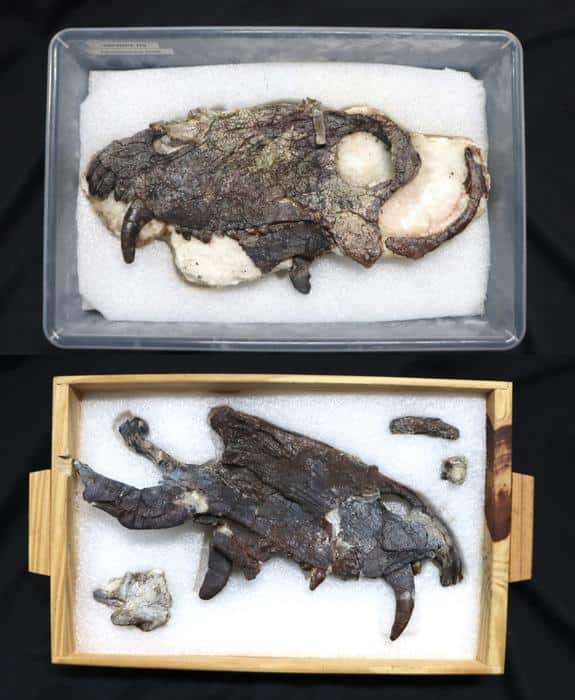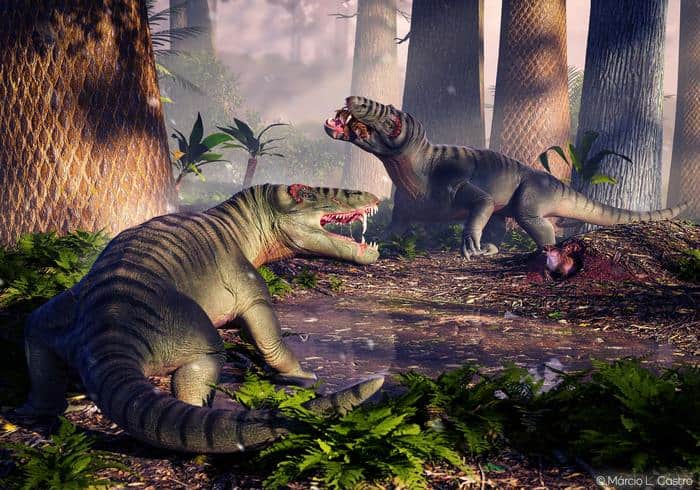Dinosaurs have a reputation for being the largest and most dangerous predators in the history. Yet, 40 million years before dinosaurs hit the scene, the largest and most bloodthirsty carnivore of its time, Pampaphoneus biccai, dominated South America.
In a new Zoological Journal of the Linnean Society study, an international team of researchers reveals the discovery of the 265-million-year-old fossil species found in the rural region of So Gabriel in southern Brazil.
“The fossil was found in middle Permian rocks, in an area where bones are not so common, but always hold pleasant surprises,” said lead author Mateus Costa Santos, a graduate student in the Paleontology Laboratory at the Federal University of Pampa (UNIPAMPA). “Finding a new Pampaphoneus skull after so long was extremely important for increasing our knowledge about the animal, which was previously difficult to differentiate from its Russian relatives.”
The fossil consists of a complete skull and several skeletal bones, including ribs and arm bones. Pampaphoneus, a member of the early therapsid clade dinocephalians, existed just prior to the largest extinction event in Earth’s history at the end of the Permian, wiping out 86 percent of all animal species.
Dinocephalians were one of the major groups of large terrestrial animals that thrived before the age of dinosaurs. There were both carnivorous and herbivorous species, which ranged in size from moderate to massive. Dinocephalians got their name from the Greek term which means “terrible head,” because their cranial bones are unusually thick. While these animals are common in South Africa and Russia, they are uncommon in the rest of the world. Only Pampaphoneus biccai is known to exist in Brazil.

The fossil was gathered by paleontologists from UNIPAMPA and Universidade Federal do Rio Grande do Sul (UFRGS) after a month of daily fieldwork. Due to the pandemic, examining and cleaning the fossil thoroughly took an additional three years.
“This animal was a gnarly-looking beast, and it must have evoked sheer dread in anything that crossed its path,” said Stephanie Pierce, of Harvard’s Department of Organismic and Evolutionary Biology and the Museum of Comparative Zoology’s Department of Vertebrate Paleontology and Mammalogy.
“Its discovery is key to providing a glimpse into the community structure of terrestrial ecosystems just prior to the biggest mass extinction of all time. A spectacular find that demonstrates the global importance of Brazil’s fossil record.”
The new skull is only the second of its kind discovered in South America. In addition to being larger than the first, the exceptional preservation of its bones means that scientists can learn more than ever about its morphology.
“Pampaphoneus played the same ecological role as modern big cats,” said Felipe Pinheiro, UNIPAMPA, on the Permo-Triassic fossil record of Brazil. “It was the largest terrestrial predator we know of from the Permian in South America. The animal had large, sharp canine teeth adapted for capturing prey. Its dentition and cranial architecture suggest that its bite was strong enough to chew bones, much like modern-day hyenas.”
Although the skull of Pampaphoneus is the largest ever discovered in its entirety at nearly 40 centimeters, research indicates that a previously unidentified fossil represents a potential third individual that was up to twice as large as the new find. Even though this species is only known from a jaw fragment, it has sufficient characteristics to be identified as Pampaphoneus.
Researchers estimate that the length and weight of the largest Pampaphoneus individuals could approach three meters and 400 kilograms, respectively. It was an accomplished predator capable of feeding on small to medium-sized prey. In the same locality where the fossil was discovered, some of its potential prey, such as the small dicynodont Rastodon and the giant amphibian Konzhukovia, have also been identified.







